This is an Eigenbau Kamera, which is German for “home made camera”. It uses regular 35mm film, but shoots very small images, probably around 12mm wide by 17mm tall. A plate on the back of the camera reads “H. Wildbore Leicester” which suggests it was made in Leicester, England by Harry Wildbore who owned a machine shop that produced lathes in the early 20th century. Beyond that, no other information is known about the camera, when or why it was made. Home made or “Franken-cameras” were not unique to Germany as one-off hobbled together prototypes exist in all countries. These cameras were probably built by someone who was good with their hands and either didn’t have the money or desire to purchase a consumer camera, deciding instead to make one themselves.
Film Type: 135 (35mm) (~12mm x ~17mm exposures)
Lens: 2.5cm f/3.5 Meyer-Görlitz Tripolan uncoated 3-elements
Focus: 0.8 meters to Infinity
Viewfinder: Scale Focus
Shutter: Prontor Leaf
Speeds: T, B, 1/25 – 1/100 seconds
Exposure Meter: None
Battery: None
Flash Mount: None
Weight: Unknown
Manual: None
The Voncabbage Collection
 In the fall of 2021, I had the opportunity to visit the Voncabbage Collection, one of the largest private collections of cameras in the world. The owner of this collection wishes to remain anonymous, but granted me full access to thousands of rare and unusual cameras, many of which were prototypes, one offs, or rare cameras that many collectors would go their whole lives and never see.
In the fall of 2021, I had the opportunity to visit the Voncabbage Collection, one of the largest private collections of cameras in the world. The owner of this collection wishes to remain anonymous, but granted me full access to thousands of rare and unusual cameras, many of which were prototypes, one offs, or rare cameras that many collectors would go their whole lives and never see.
Although I was able to handle and photograph any camera I wanted, when faced with literally thousands of cameras, there’s only so much time you can spend with each one. The owner let me photograph anything I wanted, but there wasn’t enough time to shoot film in any of them.
This year, I will be sharing some of the photos of cameras I took in a series of Voncabbage Collection reviews, along with whatever I could find about each one.. These reviews will be shorter, and sometimes missing things that I was unable to discover in the short time I handled them, but I’ll still do my best to find whatever I can!
What I Know
Now, this is a weird one. In a previous review for the Klosterlechfeld Riwa, which is another prototype camera from the Voncabbage collection, I theorized this was some sort of prototype or proof of concept from a company looking to create a new type of camera. Although the camera was a bit rough around the edges, it had the feel of something that was intended to go into mass production, but for reasons we’ll likely never know, didn’t’.
This Eigenbau Kamera is clearly a home made custom built camera, made probably by one person, for what appears to be a very specific purpose. Unlike the Riwa which has nice curves to the body, suggesting that some thought went into it’s cosmetics, this Eigenbau Kamera appears to be all function over form. It is so proprietary, it doesn’t even have a name. The overall shape of the body loosely reminds me of the Wirgin Edinex with the two bulges on each side of the camera, but this camera’s much larger size eliminates any chance that this is a repurposed Wirgin.
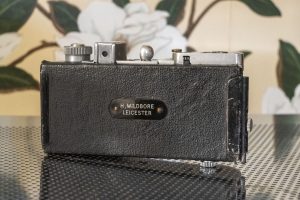
The only clue to the camera’s history is the plate on the back of the camera that reads “H. Wildbore Leicester” which suggests it was made in Leicester, England by Harry Wildbore who owned a machine shop that produced lathes in the early 20th century. Beyond that, no other information is known about the camera, when or why it was made.
The Meyer-Görlitz Tripolan and dial set Prontor shutter suggest something before World War II, perhaps even as early as the 1920s, but with a huge supply of spare parts likely available before and after the war, this could have been built in the 1950s using old parts. My best guess would be during or right after the war, as getting cameras out of Germany was impossible, and some local photographers would had to turn to home built or other custom cameras. Perhaps Mr. Wildbore was also a hobbyist photographer and used his skills at using lathes and other machinery to construct this camera, or perhaps he did it for someone else.
At first glance, the appearance of this camera feels hobbled together, but strangely, it all seems to work well with surprisingly good ergonomics further suggesting someone with metal working experience created it.. The effort that went into making this thing is impressive as it has a number of pretty advanced conveniences such as a top plate shutter release, rapid film advance lever, built in shutter/lens cap, and a hinged easy loading film transport.
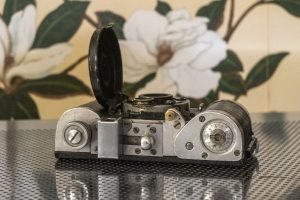
The top plate is quite interesting, starting with a large and easy to grip rewind knob. The knob is spring loaded, allowing you to pull up on it to move the fork out of the way when loading in a standard 35mm cassette of film.
Next is the straight through optical viewfinder, whcih is small, but no more than other 35mm cameras of the day. Next is a sliding chrome lever that acts as the film transport. The camera produces very small images about 12mm wide, so the movement of the film advance is not very long. A quick flick of the finger moves this lever to the right, advancing the film, and readying it for the next shot.
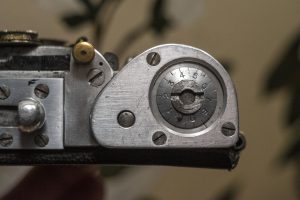
Above and to the right of of the film advance is a brass shutter release button, which is cleverly designed to use the threaded cable release socket of the Prontor shutter. Pressing down on this button pushes a rod through the socket, firing the shutter. Amazingly, the location and throw of the shutter release is perfectly positioned in easy reach of the photographer’s right index finger.

Below and to the right of the shutter release is the top of a small round shaft with a small black dot engraved, which rotates as film passes over the sprocketed shaft in the film compartment when film transports through the camera. It is small details like this, that impress me the most as small details like these would often be overlooked on a simple homebrew camera.
Finally, to the right is the exposure counter. I did not get a chance to shoot the camera, so how this exposure counter works is not certain, but a small clockwise arrow suggests it is a subtractive counter, counting how many exposures remain. The counter is engraved with the numbers 0 to 9 which is also strange as due to the extremely small size of the exposed images this camera would make, even on an 18 or 20 exposure roll of 35mm film (which would have been common around WWII), you would get quite a number higher than that. At less than a third the width of a normal 24×36 exposure of film, a 20 exposure cassette would produce at least 60 images, and a 36, well over a hundred.
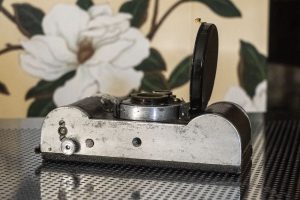
The bottom of the camera has a centrally located 1/4″ tripod socket, which further suggests this camera’s British heritage, as a German made camera from this era would have likely still had a 3/8″ socket. The function of a small geared knob on the side under the take up spool is used when rewinding film back into the cassette at the end of a roll of film. An unfortunate consequence of this knob on the bottom of the camera, means it will never sit level on a flat surface as the camera constantly wants to tip forward.
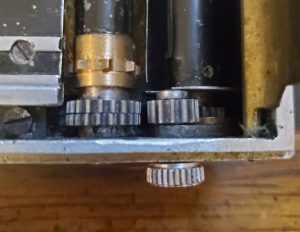
Taking a closer look at this knob, it works by loosening a coupling gear inside of the film compartment that connects a gear on the sprocket shaft to another at the bottom of the take up spool. With the knob loosened, the coupling gear can be slid to the side, decoupling it from the gear, allowing you to rewind the film. Once you’ve loaded in a new roll of film, slide this gear back to it’s original location and tighten it down, and the two gears are re-coupled.
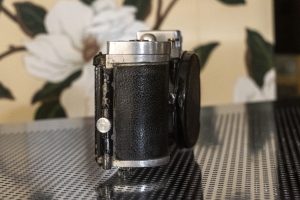
On the camera’s right side is a small chrome knob that is connected to a sliding shaft that functions as the lock for the camera back. Sliding this knob up moves a pin out of the way allowing you to completely remove the film back, revealing the film compartment. Also note the narrow depth of the camera front to back when the hinged lens/shutter cap is closed.
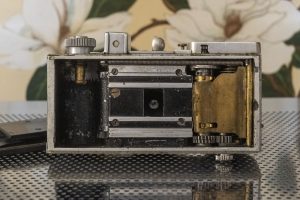
Inside the film compartment, we finally get to see the very tiny size of the film gate which exposes what I estimate to be 12mm wide by 17mm high images. This size suggests a subminiature camera, but the size of a 35mm camera!
Is it this tiny size that gives us the best hint that this camera was not designed for general photography as there would have been no reason to make images this small. In fact, with film prices being very high before, during, and after the war, anyone making their own camera would not have wanted to waste film above and below the exposed image. Sure, you can get more images than exposing the full 24×36 frame, but the vertical height of each image would have left a good 7mm of unexposed film above and below each shot.
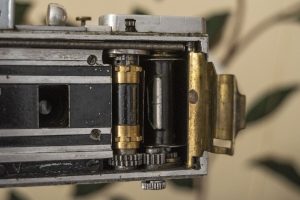
Film transports from left to right onto a fixed metal take up spool. The spool hides behind a hinged brass door which helps maintain contact with the film as it passes over the two brass sprockets. The exposed gears beneath the take up spool and shaft are impressive, and further my admiration to the work put in by whoever built it.
A very long spring, running almost the entire length of the film compartment is connected to the film transport slider on top of the camera and rotates both the take up spool and sprocket shaft as film is transported through the camera. Why exactly such a long spring was used, when a much shorter one would have worked is anyone’s guess and adds even more mystique to this camera.
Finally, a small opening on the back of the top plate of the camera, exposes a small gear relating to the film transport under the top plate. The purpose of this opening is unknown, and only seems to allow gunk to get into the camera.
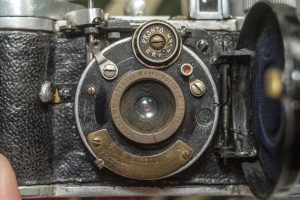
Up front, the dial set Prontor shutter is probably the most normal part of this camera as it functions as other similar shutters did. A dial above the lens selects three shutter speeds from 1/25 to 1/200, plus two more positions for T and B.
A brass slider along the bottom edge of the camera operates the diaphragm, allowing you to select apertures from f/3.5 to f/8. Focus is controlled by rotating the front lens grouping indicated by an etched groove and focus scale from 0.8 meters to infinity.
The Prontor shutter’s original self-cocking shutter release is on the front face of the camera, near the 10 o’clock position around the lens. Although the top plate shutter release uses the cable release socket on the shutter, you can also fire the shutter with this lever if you so choose. Regardless of which shutter release you use, there is no need to separately cock the shutter before each exposure, so it is important to remember to advance the film after each shot, or else risk double exposing your shot. A second, smaller lever indicated with a red dot near the 2 o’clock position around the lens is a self-timer.
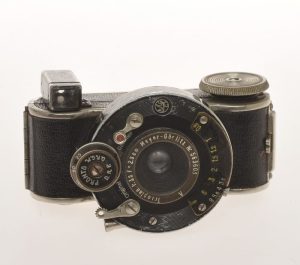
One final mystery to the camera is the focal length of the Meyer Trioplan lens. At 2.5cm, this would be a fairly wide angle lens, especially for the era in which it was made, but with the unusually small images, would probably compare to close a standard focal length. The Trioplan’s 567235 serial number further suggests this lens was built in the early 1930s. While researching this article, I found a matching lens and shutter on a Fotofex Minfex 16mm subminiature camera from the early 1930s suggesting that this is where this combination came from.
Unlike the Minfex however, this camera has a neat blue velvet lined hinged cap that when closed, completely covers the shutter and lens, protecting it from the elements. A small metal latch to the left of the shutter keeps the latch closed when the camera is not in use.
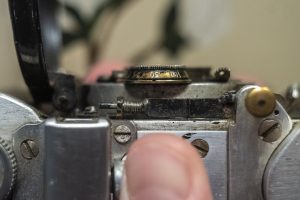
The entirety of this Eigenbau Kamera is shrouded in mystery. With it’s German shutter and lens, but British build quality, perhaps I shouldn’t even give it a German name, but that’s what’s so fun about these home made cameras, why, who, what, where, and when?!
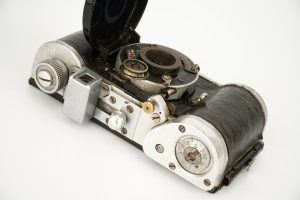
One final bit of information regarding this camera was that it was previously purchased in October 2019 at a Flint’s Auction in Thatcham, England, suggesting this camera has spent most of it’s life in the country of it’s origin, before making it “across the pond” where I was fortunate enough to come across it.
Exactly how many cameras like this were hobbled together by craftsman out of spare parts is unknown, and impossible to measure, but I have to imagine that of those out there, few are as elaborate and thoughtfully design as this Eigenbau Kamera. With such distinct looks, good ergonomics, high quality machining, and such an unusual exposed image size, this truly is, a one of a kind camera.
Related Posts You Might Enjoy
External Links
https://www.flintsauctions.com/auction/lot/289-a-prototype–homemade-camera/?lot=2601&sd=1#

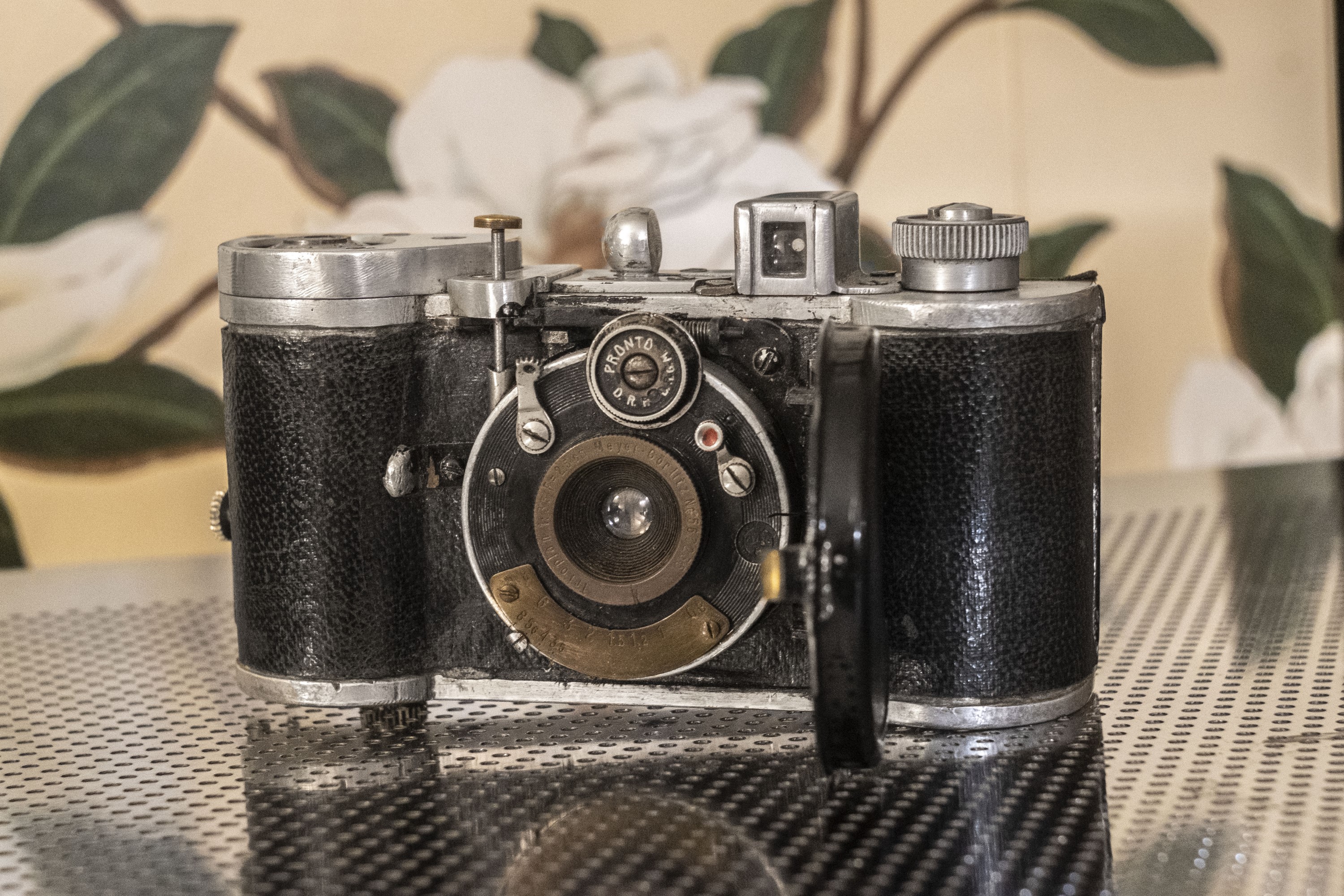
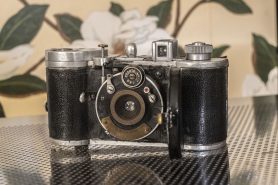
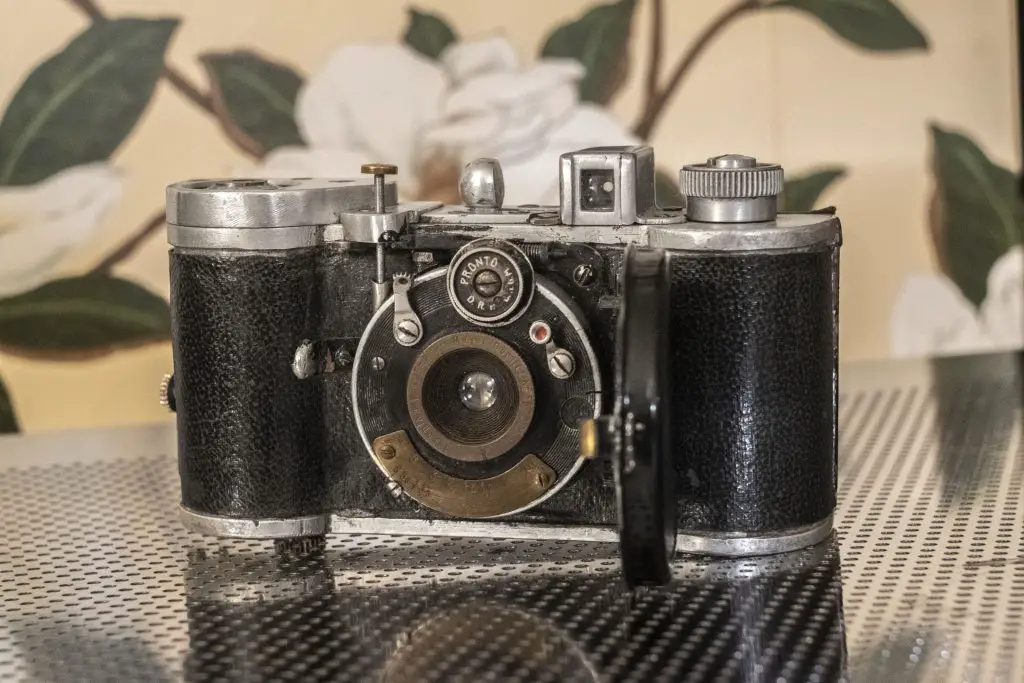
Rube Goldberg designed cameras? Never knew that before this review. What a find, Mike!
“Houston, we’ve got a (small) problem.” I’ve never read or heard of “Meyer Tripolan” lens. I took a close look at the photo of the dial-set Prontor shutter, which reveals a TRIOPLAN 1:3.5 F=2.5 Meyer-Gorlitz lens. Otherwise, an interesting tale of a hand built mechanical camera that makes the most out of 135 film.;)
Really interesting post. I’m from Leicester but have never heard of this company, Leicester had a lot large and small engineering companies at one time. Quite a few of my friends worked in them. The only camera related companies I know about are Reid & Sigrist, and Cooke Optics (Rank Taylor Hobson) who still make lenses today, and are used by Hollywood filmmakers..
My immediate response on seeing the first image was, as you say, a Wirgin Edinex, with which this camera does resemble in many ways. Even down to the grain of the body covering on the front, which is easily recognisable and comparable to that on my Edinex. As the Edinex uses a collapible mount for the shutter and lens the short distance from the front of the body easily accommodates the 2.5cm focal length of this Tripolan. On a balance of probablity I’d say the donor camera was indeed an Edinex, but highly modified.
Far more interesting than contemplating this camera’s progeny is what lies behind the reason for adopting the approx. image size of 12x17mm to use with 35mm film. From its construction it does look as though it was intended as a snap shot camera and not a specialist for some other purpose. So much film is wasted and the finished product could hardly be described as a sub-miniature camera! Did the constructor simply have a 2.5cm lens and shutter mechanism lying around and undertook this project to use it? Was it, as with Barnack’s early prototypes, indeed a prototype of its own? It’s a pity that we’ll probably never know, which keeps alive the mystery!
As for this gentleman’s reasons, there are others who engage in DIY that can surprise us. I’ve sent you some images of a wooden ERC made exclusively for an Exa 250 or 500. Clearly a talented cabinet maker, but why, especially as the regular case would have been readily available? It was its eccentricity that prompted me to acquire it as it is likely to be one of a kind.